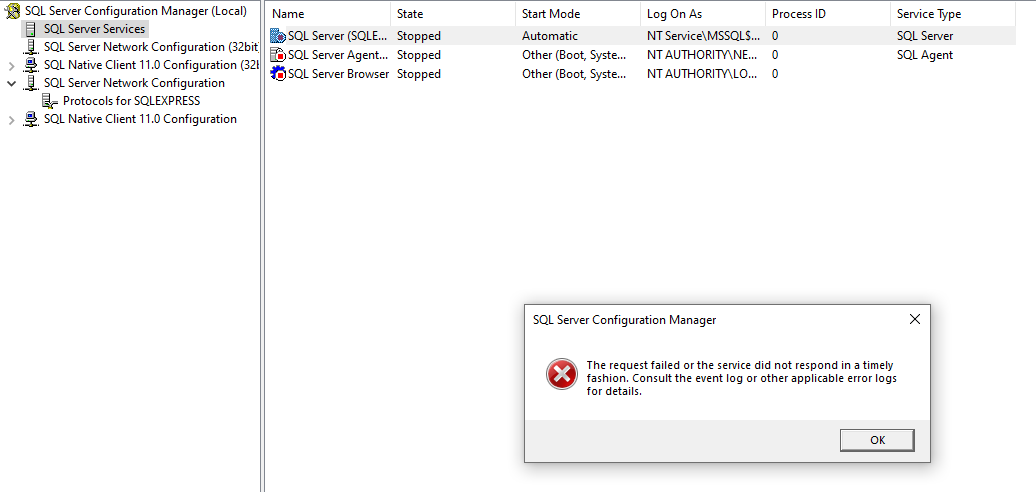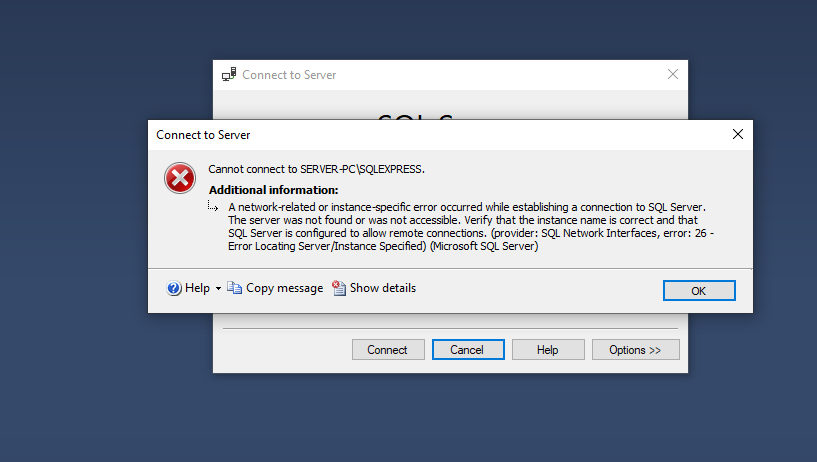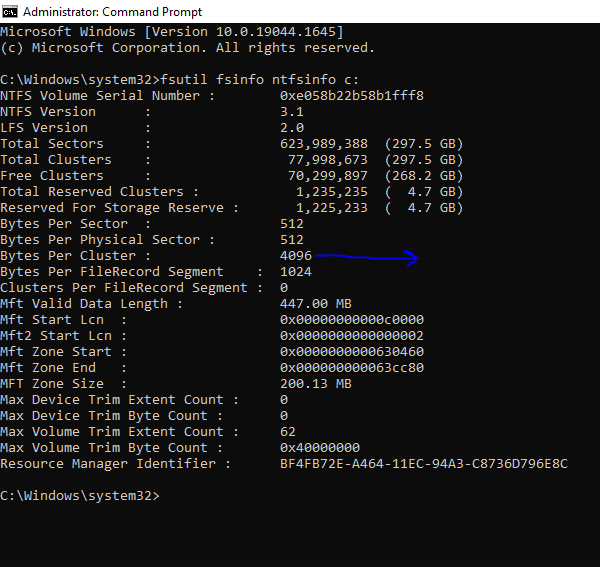SQL SERVER 2017 EXPRESS SERVICES FAIL TO START. Error
I TRIED TO REPAIR BY RUNNING REPAIR WIZARD I GOT THIS ERROR
Overall summary:
Final result: Failed: see details below
Exit code (Decimal): -2061893606
Start time: 2023-04-15 14:13:40
End time: 2023-04-15 14:21:26
Requested action: Repair
Setup completed with required actions for features.
Troubleshooting information for those features:
Next step for SQLEngine: Use the following information to resolve the error, and then try the setup process again.
Machine Properties:
Machine name: SERVER-PC
Machine processor count: 4
OS version: Microsoft Windows 10 Pro (10.0.19044)
OS service pack:
OS region: United States
OS language: English (United States)
OS architecture: x64
Process architecture: 64 Bit
OS clustered: No
Product features discovered:
Product Instance Instance ID Feature Language Edition Version Clustered Configured
SQL Server 2017 SQLEXPRESS MSSQL14.SQLEXPRESS Database Engine Services 1033 Express Edition 14.0.1000.169 No Yes
Package properties:
Description: Microsoft SQL Server 2017
ProductName: SQL Server 2017
Type: RTM
Version: 14
SPLevel: 0
Installation location: C:\Users\SERVER\Downloads\SQLEXPR_x64_ENU\x64\setup\
Installation edition: Express
User Input Settings:
ACTION: Repair
AGTDOMAINGROUP: <empty>
AGTSVCACCOUNT: NT AUTHORITY\NETWORKSERVICE
AGTSVCPASSWORD: <empty>
AGTSVCSTARTUPTYPE: Disabled
ASCONFIGDIR: Config
ASSVCACCOUNT: <empty>
ASSVCPASSWORD: <empty>
ASTELSVCACCT: <empty>
ASTELSVCPASSWORD: <empty>
ASTELSVCSTARTUPTYPE: 0
CLTSTARTUPTYPE: 0
CLTSVCACCOUNT: <empty>
CLTSVCPASSWORD: <empty>
CONFIGURATIONFILE:
CTLRSTARTUPTYPE: 0
CTLRSVCACCOUNT: <empty>
CTLRSVCPASSWORD: <empty>
ENU: true
EXTSVCACCOUNT: <empty>
EXTSVCPASSWORD: <empty>
FAILOVERCLUSTERGROUP: <empty>
FAILOVERCLUSTERNETWORKNAME: <empty>
FTSVCACCOUNT: <empty>
FTSVCPASSWORD: <empty>
HELP: false
IACCEPTPYTHONLICENSETERMS: false
IACCEPTROPENLICENSETERMS: false
INDICATEPROGRESS: false
INSTANCENAME: SQLEXPRESS
ISMASTERSVCACCOUNT: NT AUTHORITY\Network Service
ISMASTERSVCPASSWORD: <empty>
ISMASTERSVCPORT: 8391
ISMASTERSVCSSLCERTCN: <empty>
ISMASTERSVCSTARTUPTYPE: Automatic
ISMASTERSVCTHUMBPRINT: <empty>
ISSVCACCOUNT: NT AUTHORITY\Network Service
ISSVCPASSWORD: <empty>
ISSVCSTARTUPTYPE: Automatic
ISTELSVCACCT: <empty>
ISTELSVCPASSWORD: <empty>
ISTELSVCSTARTUPTYPE: 0
ISWORKERSVCACCOUNT: NT AUTHORITY\Network Service
ISWORKERSVCCERT: <empty>
ISWORKERSVCMASTER: <empty>
ISWORKERSVCPASSWORD: <empty>
ISWORKERSVCSTARTUPTYPE: Automatic
MRCACHEDIRECTORY:
QUIET: false
QUIETSIMPLE: false
SQLSVCACCOUNT: NT Service\MSSQL$SQLEXPRESS
SQLSVCPASSWORD: <empty>
SQLTELSVCACCT: NT Service\SQLTELEMETRY$SQLEXPRESS
SQLTELSVCPASSWORD: <empty>
SQLTELSVCSTARTUPTYPE: Automatic
SUPPRESSPRIVACYSTATEMENTNOTICE: false
UIMODE: AutoAdvance
X86: false
Configuration file: C:\Program Files\Microsoft SQL Server\140\Setup Bootstrap\Log\20230415_141339\ConfigurationFile.ini
Detailed results:
Feature: Database Engine Services
Status: Failed
Reason for failure: An error occurred during the setup process of the feature.
Next Step: Use the following information to resolve the error, and then try the setup process again.
Component name: SQL Server Database Engine Services Instance Features
Component error code: 0x851A001A
Error description: Wait on the Database Engine recovery handle failed. Check the SQL Server error log for potential causes.
Error help link: https://go.microsoft.com/fwlink?LinkId=20476&ProdName=Microsoft+SQL+Server&EvtSrc=setup.rll&EvtID=50000&ProdVer=14.0.1000.169&EvtType=0xD15B4EB2%400x4BDAF9BA%401306%4026&EvtType=0xD15B4EB2%400x4BDAF9BA%401306%4026
Feature: SQL Browser
Status: Passed
Feature: SQL Writer
Status: Passed
Feature: SQL Client Connectivity
Status: Passed
Feature: SQL Client Connectivity SDK
Status: Passed
Feature: Setup Support Files
Status: Passed
Rules with failures:
Global rules:
There are no scenario-specific rules.
Rules report file: C:\Program Files\Microsoft SQL Server\140\Setup Bootstrap\Log\20230415_141339\SystemConfigurationCheck_Report.htm
The following warnings were encountered while configuring settings on your SQL Server. These resources / settings were missing or invalid so default values were used in recreating the missing resources. Please review to make sure they don’t require further customization for your applications:
Service SID support has been enabled on the service.
Service SID support has been enabled on the service.
The following resources could not be configured during repair without additional user input. Review the warnings to understand your next steps:
The service failed to start for an unknown reason. For more information, see the event logs and the SQL Server error logs.
I CAN’T LOGIN USING SSMS TOO. I GOT THIS ERROR .
===================================
Cannot connect to SERVER-PC\SQLEXPRESS.
===================================
A network-related or instance-specific error occurred while establishing a connection to SQL Server. The server was not found or was not accessible. Verify that the instance name is correct and that SQL Server is configured to allow remote connections. (provider: SQL Network Interfaces, error: 26 - Error Locating Server/Instance Specified) (.Net SqlClient Data Provider)
------------------------------
For help, click: https://docs.microsoft.com/sql/relational-databases/errors-events/mssqlserver--1-database-engine-error
------------------------------
Error Number: -1
Severity: 20
State: 0
------------------------------
Program Location:
at System.Data.SqlClient.SqlInternalConnectionTds..ctor(DbConnectionPoolIdentity identity, SqlConnectionString connectionOptions, SqlCredential credential, Object providerInfo, String newPassword, SecureString newSecurePassword, Boolean redirectedUserInstance, SqlConnectionString userConnectionOptions, SessionData reconnectSessionData, DbConnectionPool pool, String accessToken, Boolean applyTransientFaultHandling, SqlAuthenticationProviderManager sqlAuthProviderManager)
at System.Data.SqlClient.SqlConnectionFactory.CreateConnection(DbConnectionOptions options, DbConnectionPoolKey poolKey, Object poolGroupProviderInfo, DbConnectionPool pool, DbConnection owningConnection, DbConnectionOptions userOptions)
at System.Data.ProviderBase.DbConnectionFactory.CreateNonPooledConnection(DbConnection owningConnection, DbConnectionPoolGroup poolGroup, DbConnectionOptions userOptions)
at System.Data.ProviderBase.DbConnectionFactory.TryGetConnection(DbConnection owningConnection, TaskCompletionSource`1 retry, DbConnectionOptions userOptions, DbConnectionInternal oldConnection, DbConnectionInternal& connection)
at System.Data.ProviderBase.DbConnectionInternal.TryOpenConnectionInternal(DbConnection outerConnection, DbConnectionFactory connectionFactory, TaskCompletionSource`1 retry, DbConnectionOptions userOptions)
at System.Data.ProviderBase.DbConnectionClosed.TryOpenConnection(DbConnection outerConnection, DbConnectionFactory connectionFactory, TaskCompletionSource`1 retry, DbConnectionOptions userOptions)
at System.Data.SqlClient.SqlConnection.TryOpenInner(TaskCompletionSource`1 retry)
at System.Data.SqlClient.SqlConnection.TryOpen(TaskCompletionSource`1 retry)
at System.Data.SqlClient.SqlConnection.Open()
at Microsoft.SqlServer.Management.SqlStudio.Explorer.ObjectExplorerService.ValidateConnection(UIConnectionInfo ci, IServerType server)
at Microsoft.SqlServer.Management.UI.ConnectionDlg.Connector.ConnectionThreadUser()



